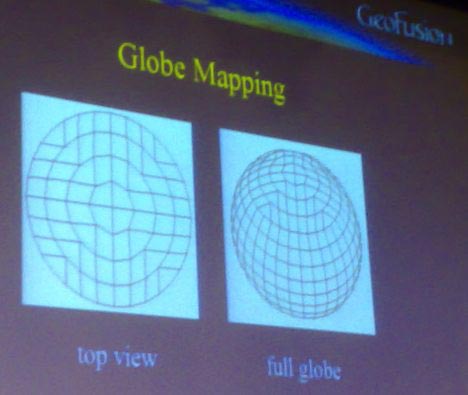Here are some highlights and news tidbits from ISDE5, which is now well and truly over. This is what was new and/or startling to me:
- “Mercator Disease”: A term coined by the Heinz Center‘s Robert Corell in his speech on climate change wherein people lack appreciation of the polar regions of the globe as a result of a lifetime spent staring at Mercator projections.
- “Carbon fees”: An alternate name for “carbon taxes” Goldman Sachs came up with and which Corell supported, because everyone is okay with paying fees, but not taxes.
- “Charismatic megafauna”: Used by Google’s Rebecca Moore to describe the type of animals that get the most “air play” when it comes to environmental outreach: Elephants, polar bears, whales, lions…
- “Biocultural diversity protection”: What Mark Plotkin and the Amazon Conservation Team are trying to preserve when they empower Amazonian indian tribes by helping them create maps of their protected areas.
- You will soon be able to subscribe to GeoRSS in Google Earth. That’s what Google’s Brian McClendon said in response to a direct question.
- As for KML in Microsoft Virtual Earth? Microsoft’s Bill Gail did not answer “yes” directly when asked if KML is coming to their mapping app, but did say that they are looking closely at KML, and that they “realize the importance of KML in the community”.
- Appalachian Voices‘s Mary Anne Hitt gave a very effective presentation about the group’s experience using Google Earth to publicize their cause, and the boost they got when their layer became a default layer in Google Earth.
There’s more coming: Appalachian Voices are going to build a service that for a given house in the region returns the nearest coal-fired electricity plants, and then the mountain-top removal mines that feed them. Also coming: Heat maps pointing to commercial wind potential on mountaintops. This is intended to show that if you remove a mountain top, there is an opportunity cost, because wind farms are an alternative.
- ESRI ArcGIS Explorer supports Flash inside a popup, ESRI’s Bern Szukalski showed in his presentation.
- In addition to the United States Holocaust Memorial Museum’s default Darfur layer in Google Earth, and Amnesty’s web site, Microsoft’s Bill Gail announced that Microsoft had been working on a Darfur project for 8 months now, which promises realt-ime news feeds, weather and information on villages, all with GeoEye images.
- Microsoft’s Bill Gail spent some time on the idea of connecting the exterior to the interior on a virtual globe — with as example the ability to show accurate renditions of the interiors of museums. Expect Microsoft Virtual Earth to perhaps focus more on bringing building interiors into the navigatable space.
- Pedro Yarza from Spains AEPO demoed a cool product for visualizing the physical state of roads using Google Earth. He’s put some YouTube videos up on the session wiki where you can see this very innovative use of KML in action.
- Andrew Fleming at the British Antarctic Survey quizzed the different virtual globe producers about the possibility of getting a better projection near the poles. Both Google Earth and Microsoft Virtual Earth currently suffer from an inability to project a layer across the poles, and the poles themselves are a nightmare.
It turns out that GeoFusion — which is more of a core 3D tools company than a end-user virtual globe creator — uses a projection that does not suffer from these drawbacks. It’s called the Geomatrix tiling system. Here is a text description, and here is a PDF description. Better yet, the ideas behind geomatrix are free for all to use, and this fact seemed to take most people at the conference by surprise. (Precise quote by Chuck Stein: “GeoFusion doesn’t claim what we do as proprietary. We would love everyone to use our model.”)
Hopefully all this will soon lead to some decent visualization tools near the poles. Here is a snapshot from a GeoFusion slide showing what the geomatrix tiling system looks like:
